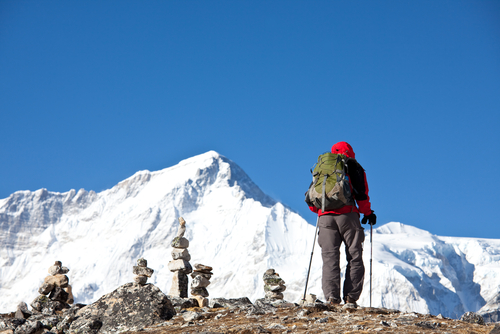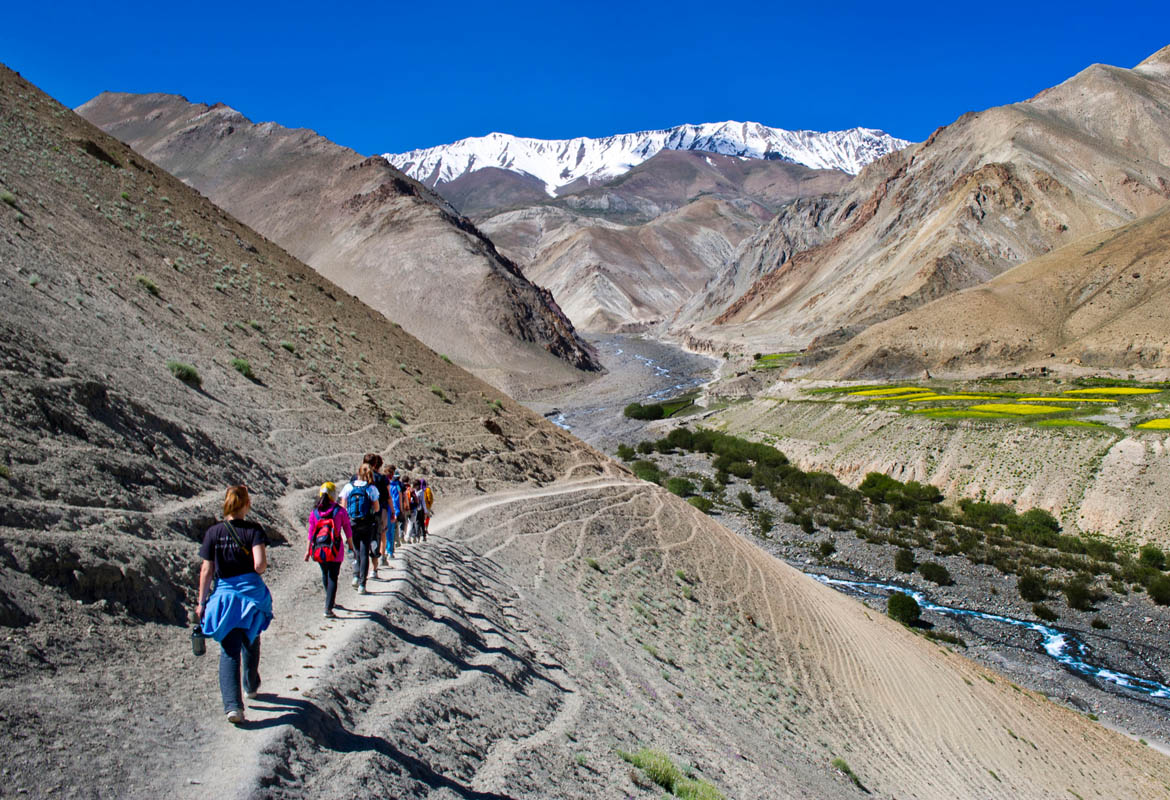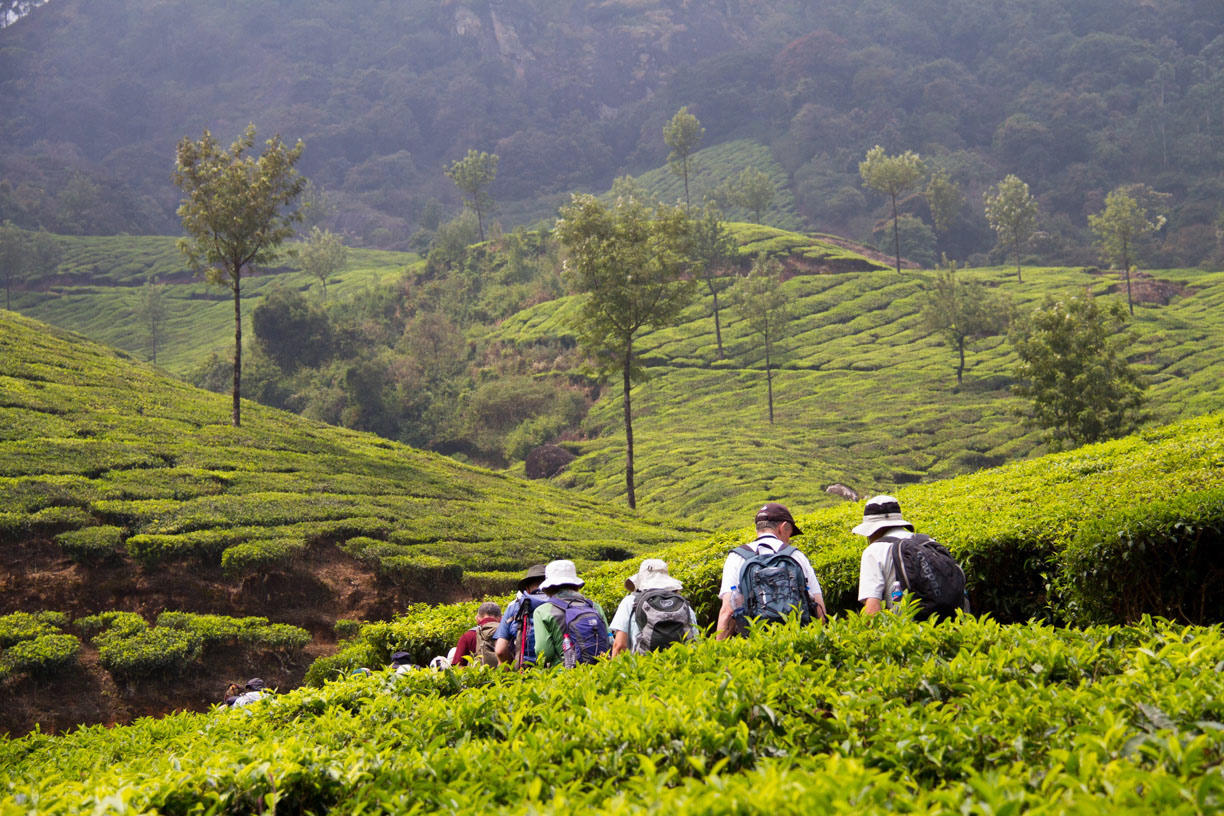
Goecha La Trek
Goecha La Trek is very different from trekking anywhere else or any other part of the Indian Himalayas. Our 21-day tour takes you on an incredible journey in the mountains. In the shadow of the 8000-m Kangchendzönga, in the Singalila range, the trek starts in the border area between India and Nepal. Leading deep into the heart of the Himalayas on promising mountain trails, discover a world of glaciers and peaks with the third highest mountain on earth. Pass through small villages and hamlets, get used to the altitude step by step and camp in the most beautiful campsites. Mules and yaks take care of luggage transport. And again and again, the breathtaking view of the high and highest mountains of the Himalayas while surrounded by oak and rhododendron forests, Himalayan firs and mountain bamboo. Maybe you can even spot the red panda in the wild! In the "tea city" Darjeeling and in Sikkim, take on the journey of discovery- the monasteries Dubdi and Tashiding are central testimonies of Tibetan Buddhism. The highlight is the Goecha La View Point, 4690 m, is that you face the mighty Kangchendzönga directly.
- Tour Duration: 20 Nights / 21 Days
- Places Covered: Kalimpong(1) > Gangtok(1) > Chewa Bhanjyang(3) > Dhor(1) > Pare Megu(1) > Has Pokhri(1) > Gomathang(2) > Tikip Chu(1) > Dzongri(1) > Lobni(1) > Thangsing(1) > Tsokha(1) > Yoksam(1) > Darjeeling(2) > Delhi(2)
-
Day 1: Arrive Delhi – Bagdogra (flight) – Kalimpong
Arrive in Delhi, and board flight to Bagdogra in West Bengal. On arrival, transfer by vehicle to Kalimpong. Embark on a winding journey (60 km / 3 h) through beautiful teak stands from the heat of the lowlands to Kalimpong, 1250 m. The small Himalayan city was formerly a thriving trade center between Nepal and Tibet. It was alternately governed by the Bhutanese kings and the princes of Sikkim. The stately houses still tell of this time. Mountaineer and explorer Heinrich Harrer and Everest's first climber Edmund Hillary also felt at home here. From Deolo Hill, at 1,700 meters the highest point in Kalimpong, you can enjoy the first wonderful view of the Kangchendzonga in good weather. Meals – Lunch & dinner. Overnight stay in the hotel.
-
Day 2: Kalimpong – Gangtok (75 kms / 3.5 hrs)
The onward journey (75 kms / 3.5 hrs) begins after a stroll across the bazaar, where the market is bustling. You will soon reach the Teesta River and thus the border with the former Kingdom of Sikkim. The scenic route leads ever deeper into the green mountains on the southern slope of the Himalayas. The destination is Gangtok, the capital, located 1,800 meters above sea level. It is considered the cultural link between Nepal, India, and Bhutan. Visit the monasteries Rumtek and Enchey, which was built in the Baroque style. After moving into the hotel rooms, take a walk through the old town. The center of Tibetan Buddhism is surrounded by beautiful bamboo, deciduous and coniferous forests. Gangtok is mainly inhabited by Nepalese, but Lepchas and Bhotias are also located here. Meals – Breakfast, lunch & dinner Overnight stay in the hotel.
-
Day 3: Gangtok – Uttarey (140 kms / 7 hrs)
The vehicle takes you in many bends and on a varied journey to the village of Uttarey, 2050 m. You will pass beautiful forests and vast tea plantations. The road conditions change from very good to bad - everything is possible. After a long drive (140 kms / 7 hrs) you will reach the settlement in the west of the country and thus the starting point for the Kangchendzönga trek. Move into the rooms in the simple guest house Green Valley. You can discuss the program of the following days with your cultural and mountain guide. Equipment check. Final preparations are made. Meals – Breakfast, lunch & dinner. Overnight stay in the hotel.
-
Day 4: Uttarey - Chewa Bhanjyang
Early risers take a trip to the women's monastery just above the village. Here, a few nuns run a small gompa with a stupa and flower garden. Your luggage will be loaded onto mules, then your Kangchendzönga trekking begins. The Simphok Chu (Chu = river) is the first signpost on the climb to the Singalila ridge. Pass by a fish breeding station and follow the narrow cobbled path through beautiful rainforest. Orchid bulbs crouch in branch forks. Gurgling sources and the clear concert of the birds provide jungle music. The mules carry your luggage up to the Singalila Range in the immediate border area between India and Nepal. From here the chains of the Singalila Mountains can be seen in good weather. The first camp is for two nights at Chewa Bhanjyang, 3100 m. Meals – Breakfast, lunch & dinner Overnight at the tents
-
Day 5: Trek to Singalila Peak, 3618 m
Acclimatization is now the "first mountaineering obligation" and a real treat in the Singalila National Park. Because climbing the 3618-meter-high Singalila Peak does not promote your height adjustment. The views of the snow and ice-covered Himalayan peaks are also becoming more powerful step by step. In addition to the eight-thousanders, there are also famous seven-thousanders such as Kumbhakarna and Kabru. But the most impressive is the Kangchendzönga with its 8586-meter-high main summit and the four secondary peaks, which - with the exception of the 7902-meter-high Kangbach - are also around 8500 meters. In the Tibetan language, Kangchendzönga means "the five treasure troves of eternal snow". Meals – Breakfast, lunch & dinner Overnight stay at the tents.
-
Day 6: Chewa Bhanjyang – Dhor
After breakfast, you will walk along the Singalila ridge in a northerly direction. The path is characterized by a thick cloud forest. When the sun's rays bathe their magical light in the swaths, strange magic lies over the country. Ascent to a first pass, 3525 m, and then steadily up and down along the border ridge. They look to Nepal on the left and Sikkim on the right and head for a small yakalm. Prayer flags flutter in front of white ice peaks. Finally, the tents are erected at Dhor, 3700 m. In good weather, there is a special spectacle in the evening: when the sun sinks behind the eight-thousanders Everest and Makalu. Meals – Breakfast, lunch & dinner. Overnight stay in tents.
-
Day 7: Dhor - Pare Megu
The Kangchendzönga is already quite close and shines in the first sunlight. The mules have long since been replaced by yaks, who are now responsible for luggage transport. Now follow the beautiful panorama path to Pare Megu and marvel at the wide rhododendron forests and rhubarb stocks. The country smells and smells. Red-colored knotweed can be found between the rock gardens. For lunch you are served beautiful views of the ice giants Jannu and Makalu. In the rhythm of the Himalayas, you hike with many ups and downs and over several small passes to the settlement of Pare Megu, 3900 m. They look forward to dinner - perhaps the chef today serves the tasty Nepalese national dish Dal Bhat, the basic ingredients of which are rice and lentils, tomatoes, Meals – Breakfast, lunch & dinner. Overnight stay in the tents.
-
Day 8: Pare Megu - Garakhet - Has Pokhri
After breakfast there is an opportunity to visit a nearby Yakalm. A beautiful ascent with a sublime view of the Kabru massif then takes you to the Garakhet Pass, 4290 m. You are still in the border area with Nepal and will also "change sides" today. Rhododendrons and Helmlock firs determine the landscape before the tree line is reached. At the top of the pass, there is a sacred lake with a stone altar and many stone slabs. The lower daily target is clearly visible from here. Descent to Has Pokhri (Pokhri = lake), 4170 m, on whose banks you camp in a beautiful mountain landscape. Meals – Breakfast, lunch & dinner. Overnight stay in tents.
-
Day 9: Has Pokhri - Gomathang
Pass the holy lake Lam Pokhri, climb to the Danphe Pass, 4480 m. Chords and prayer flags adorn the important transition. The eight-thousand-meter Makalu is again a coveted photo motif. The ice domes of the Kangchendzönga massif appear like a wall on the steep descent through the most beautiful, wild mountain jungle to the cozy Gomathang meadow camp, 3800 m (two nights). In autumn, the leaves of the trees have already discolored and give the country its red-gold and ocher-colored dress. Well-deserved rest after a long day. The hot tea and the warm soup are good for you. Meals – Breakfast, lunch & dinner Overnight at the tents.
-
Day 10: Rest and Reserve Day
Rest and reserve day A deserved rest day that you can use to relax from the previous exertions. You enjoy free time in one of the most hidden corners of the Himalayas and let yourself be spoiled with modest means from the trekking kitchen. Meals – Breakfast, lunch & dinner Overnight at the tents
-
Day 11: Gomathang - Tikip Chu
Hike over the Kamsey Pass, 4200 m, and descent in magnificent rhododendron forest down to the tent camp Tikip Chu, 3700 m (Chu = river). The "Kantsch" ice walls rise sky-high into the white clouds. It was first climbed on May 25, 1955 by George Band and Joe Brown. German expeditions have also made history on the Kangchendzönga, such as those led by Paul Bauer or GO Dyhrenfurth in the 1930s or later under Karl-Maria Herrligkoffer. In 1975 a German-Austrian expedition, directed by Siegi Aeberli and Günter Sturm, managed the second ascent of the west summit Yalung Kang. Reinhold Messner and Friedl Mutschlechner reached the main Alpine summit in 1982. A fascinating, alien world made of rugged rock faces and huge glaciers. Meals – Breakfast, lunch & dinner Overnight at the tents
-
Day 12: Tikip Chu – Dzongri
You reach the summer pastures of Dzongri, 4030 m, through a forested high valley. Finally, the path climbs steeply to the beautifully situated storage area. You enjoy the view of the six-thousand-meter Ratong and Kabru Dome and the seven-thousand-meter North Peak and South Peak. Constantly ascending on a slope, then through blockwork, the path pulls up to the 4362 meter high Dzongri pass. Sometimes rare blue sheep can be seen in the region. But colored pheasants are also at home here. The descent through blockwork, later through rhododendron and azalea stands and over pastures to Camp Dzongri, 4030 m. Meals – Breakfast, lunch & dinner Overnight at the tents.
-
Day 13: Dzongri - Thangsing – Lobni
The next goal is Lobni. You walk close to the tree line. The path climbs slightly to a small saddle. A nice crossing through huge rhododendron bushes follows. The Himalayan scenery around you is becoming increasingly dramatic. The view of the 6691-meter-high Pandim and the eight thousand meter peaks behind it of the Kangchendzönga massif is stunning. A steep descent follows through a fairytale rhododendron forest to the Kokchurung hut, 3725 m. Then follow the stream to Thangsing and on to the Lobni camp, 4130 m. The tents are set up at the foot of the end moraine of the Onglaktang glacier. Camping is no longer permitted. You are in the home of the snow leopard and eagerly listen to the stories that are told here. Meals – Breakfast, lunch & dinner. Overnight stay in the tents.
-
Day 14: Lobni - Goecha La – Thangsing
The start of the Goecha La pass begins in the morning with the headlights on. Because the view of the "Kantsch" is particularly clear and beautiful at sunrise. You climb over moraine grass slopes to the end of Lake Samiti and on to the first pass, Goecha La View Point, 4690 m. The sky-high pass approaches and lives up to its name. Because the "locked gate", the top pass of the 4950 meter high Goecha La, is also likely to be denied to us. At least that's what the Indian authorities have been doing in recent years. If there is a possibility to ascend to the top, we will use this. But the arduous climb is definitely worth it: the ice walls of the Kangchendzönga appear within reach. The third highest mountain in the world lies before you in all its glory! Magnificent view of the moraine and glacier world of the Onglaktangfirn with its large glacial lakes. A world that amazes you. Perhaps you will discover edelweiss, Himalayan pips and Helychrysum, which is also used as a curry herb. And with a bit of luck you will encounter a horde of rare blue sheep. Descent to Thangsing, 3930 m. A true royal stage! Meals – Breakfast, lunch & dinner Overnight stay at the tents
-
Day 15: Thangsing – Tsokha
Descend along the stream to Kokchurung, where you break new ground. While the pack animals take the steep path over Dzongri, you choose the fantastic path mach Pethang. It leads through a wonderful mountain forest without much up and down until you meet the pack caravan at Pethang again. After lunch you descend, partly on wooden plank paths, to Tsokha. You actively participate in the DAV Summit Club's environmental program and take back problem waste like batteries. The dirtbag, which you receive with the travel documents, provides valuable help. High Himalayan firs, birch trees and rhododendrons dominate the landscape. Finally, you will reach the abandoned Tibetan settlement of Tsokha, 3000 m, perched on an exposed rock spur. Here the tents are pitched for one night. After many days in the high mountains, the first cola or beer that a small shop offers is a real treat. Meals – Breakfast, lunch & dinner Overnight stay in tents.
-
Day 16: Tsokha – Yoksam
The trek ends in Yoksam, 1770 m, where orchids grow and butterflies jam. The descent on the adventurous jungle path between bamboo and daphne also brings you into the warmth. Maybe you spot a red panda in the wild on the way. Yoksam means something like "meeting place of the monks". The first capital of Sikkim was also the place where the early kings were enthroned. Moving into a simple hotel. The ascent to Dubdi Gompa is worthwhile: from Sikkim's oldest monastery you can enjoy a wonderful view of the Yoksam valley with the Rathong Chu river. In the evening you will say goodbye to your companions at a small party. Meals – Breakfast, lunch & dinner. Overnight stay in tents.
-
Day 17: Yuektiv – Tashiding – Darjeeling
Passes and bridges take you to the world-famous city of tea (140 km / 6 h). On the way you visit the Tashiding Monastery, the most important and holy site in the country. It was founded in 1641 and belongs to the Nyingma sect of Tibetan Buddhism. Then leave Sikkim and drive to Darjeeling. In the hotel in Darjeeling, 2185 m, you will move into your room for two nights. Until the 19th century, the small town was part of the Kingdom of Sikkim and inhabited by the Bhotia and Lepcha ethnic groups. Then the British learned to appreciate the "Hill Station" and expanded Darjeeling for a summer retreat. Meals – Breakfast, lunch & dinner. Overnight stay in the hotel.
-
Day 17: Yuektiv – Tashiding – Darjeeling
Passes and bridges take you to the world-famous city of tea (140 km / 6 h). On the way you visit the Tashiding Monastery, the most important and holy site in the country. It was founded in 1641 and belongs to the Nyingma sect of Tibetan Buddhism. Then leave Sikkim and drive to Darjeeling. In the hotel in Darjeeling, 2185 m, you will move into your room for two nights. Until the 19th century, the small town was part of the Kingdom of Sikkim and inhabited by the Bhotia and Lepcha ethnic groups. Then the British learned to appreciate the "Hill Station" and expanded Darjeeling for a summer retreat. Meals – Breakfast, lunch & dinner. Overnight stay in the hotel.
-
Day 19: Darjeeling - Bagdorga – Delhi (flight)
Transfer trip (80 km / 3.5 hrs) to Bagdogra Airport, 126 m, from where your plane takes off back to Delhi. You move into the hotel rooms for two nights and have the remaining time at your leisure. Meals – Breakfast, lunch & dinner Overnight hotel
-
Day 20: In Delhi
After a relaxing breakfast, the tour guide will pick you up from the hotel and take you for a guided sightseeing of Old and New Delhi .The Tour includes the following places: Red Fort: The term Red Fort is taken from a Hindi word Lal, which means red and Quila which means fort. The structure of the Red Fort is very uneven and it is placed in an octet shape along the Yamuna River. This fort is delimited by a wall of about 2.4 kms in perimeter and is constructed of red sandstone. In 1638, Shah Jahan started building this huge fort and it was completed in 1648. The fort has a Diwan-e-Am (Hall for public audience), a Rang Mahal (a water- cooled apartment of royal ladies) and a Pearl Mosque, which was constructed with white marble. Red fort has two hallways: a) The Delhi gate and b) The Lahori gate, and both this gates face the renowned ChandniChowk. Jama Masjid: Jama Masjid is one of the country’s major mosques where hundreds and thousands of Muslims offer their prayers even today. Jama Masjid was constructed by Shah Jahan as an architectural extravaganza in 1658. The wonders of construction in Jama Masjid are seen in the long stretches of stairs and the hefty courtyard. Chandni Chowk (Silver Street): Chandni Chowk is well-known for its flamboyant streets with the famous shopping spots of Old Delhi. It also has the country’s best known extensive market for textiles, electronic goods, and watches. Entire Chandni Chowk was designed by Jahanara Begum, Shah Jahan’s beloved daughter and was then populated by the well-to-do families of that time. The famous Parantha wale Gali, known for its mouth-watering paranthas is also positioned in Chandni Chowk. The famous gold market, Dariba Kalan is also situated here.ll-to-do families of the time. Around the area is the famed Paranthawale Gali, known for its delicious paranthas, Dariba Kalan, the gold market and well-known sweetmeats shops. Raj Ghat: A raised square platform of black marble on the banks of Yamuna River, symbolizes the spot where Mahatma Gandhi was assassinated and cremated in 1948. A dedicatory ritual is still performed every Friday, in his memory. Birla Mandir: One of the major praying spots in the city, comprising of idols of numerous divinites. It is situated close to Connaught Place. In 1938, an industrial Raja Baldev Birla constructed the Birla Mandir. India Gate: India Gate is free-standing, 42-meter high arch. It was built in 1931 and was formerly called the All India War Memorial in the memory of the 90,000 soldiers of the Indian Army who died in World War I. The names of the warriors are engraved all along the walls of the arch. The eternal flame was lit here to honor the Amar Jawan (Immortal Soldier), in 1971. Rashtrapati Bhavan (President’s House): The Rashtrapati Bhawan is the authorised dwelling place of the President of India. The residence was designed by Lutyens and was the official residence of the Viceroy when the British ruled India. Humayun’s Tomb: Nine years after the death of Humayun, Haji Begum (widow of Humayun) built this tomb in 1565-66 in his memory. Qutub Minar:The outstanding building in the Southern part of the capital was constructed by a Muslim King, Qutub-ud-din Aibak in 1199 A.D. The Minar (tower) was 72.5m tall and its base is a mosque. Bahai’s Temple: It is a very new architectural wonder of the Bahai sect. This temple is visible from quite a lot of spots in South Delhi. This temple is molded in the shape of a Lotus and has precisely been given the name. Alternatively, a trip to Agra, the former capital and residence of the Mughal emperors, with a visit to the famous Taj Mahal tomb, can be undertaken (booking and payment on site). Last hotel night in India. Meals – Breakfast, lunch & dinner. Overnight stay at the hotel.
-
Day 21: Delhi Departure
In time transfer to Delhi international airport to board onward flight.

Date & Price
Price
| Period | Standard |
|---|---|
| Valid from 01 Apr 2025 to 30 Sep 2025 | $ 1748 Per Person |
- Domestic airfare: USD 274 per person
Accommodation
| Cities | Standard |
|---|
Important Information
- 02 Paying pax Travelling Together - USD 2472 Per Pax
- 3 Paying Pax Travelling Together - USD 2396 Per Pax
- 04-06 Paying Pax Travelling Together - USD 1890 Per Pax
- 07-09 Paying Pax Travelling Together - USD 1816 Per Pax
- 10-12 Paying Pax Travelling Together - USD 1634 Per Pax
Inclusions & Exclusions
Inclusions
- Accommodation: - Sharing a twin or double room/ tent for 20 nights.
- Meals: - Full board basis. Packed lunches will be on some days.
- Transport: - Using non air-conditioned Toyota Innova Cars for all services including drop/ pick up for trek (3 pax to a car) per programme.
- Assistance & Portages: - Meeting and assistance on arrival/departure at airports, hotels by Trans India Holidays representative and portages at hotels for one standard baggage per person included.
- Entrances: - Entrances at monuments/ Monasteries and places of visit per programme only and for one time visit. Trek permit fee, Inner line fee etc.
- Guides: - Accompanied English speaking trek guide for the sightseeing and trek portion.
- All trekking arrangements including camping fee.
Exclusions
- Sleeping Bags (will have to be brought by the guests)
- Personal clothing/ trek gear including trek shoes etc
- Any insurance cover against accident, sickness and evacuation.
- Any airfares, airport taxes, and supplements quoted separately if applicable.
- Expenses of personal nature like table drinks, telephone calls, laundry, tips to drivers, guides and hotel staff.
- Any Camera fee still or video fees.







